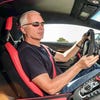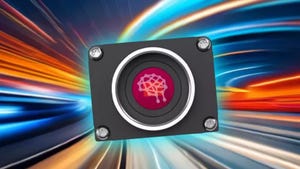The 630-HP 2024 Porsche Macan Electric Is Faster than Ever
Porsche commits to switching its top-selling model to electric power.
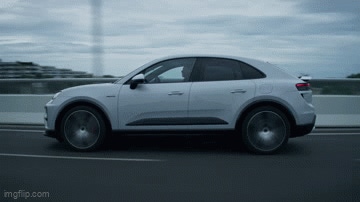
Despite recent concerns about the speed of the automotive industry’s shift to electrification potentially slowing, Porsche is demonstrating carmakers’ commitment to the change by replacing its most popular model with a new electric version.
The 2024 Macan Electric replaces the combustion version of the hot-selling compact crossover, which has found more than 800,000 customers worldwide since its 2014 debut. The Macan arrives in two versions, the $80,450 Macan 4 and the $106,950 Turbo.
These are starting prices for each, and Porsches quickly pile on expenses with charges for extras that you might expect to be included as standard equipment for so much money. Both the Macan 4 and the Turbo are all-wheel-drive. The use of the “Turbo” moniker, as seen previously on the Taycan EV, is not a reference to a physical turbocharger, but rather to the performance boost that turbochargers have historically provided for combustion engines.
When the 2024 Macan Electric reaches dealers this summer, it will mark the debut of Porsche’s new Premium Platform Electric (PPE) EV platform that will underpin additional future models. This is unrelated to the Taycan EV’s chassis.
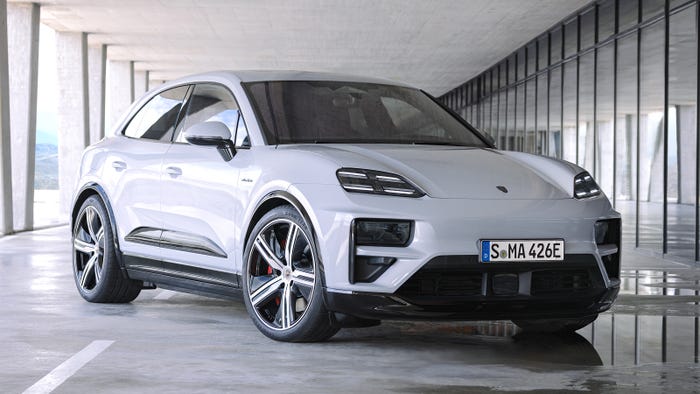
2024 Porsche Macan Electric Turbo. PORSCHE
Battery
The Macan will also employ different batteries, with different cell chemistry and different configurations of its 800-volt battery pack. The Taycan, like other 800-volt EVs, uses a transformer to step up the available voltage from 400-volt DC fast-charging stations, which adds cost and complexity and costs efficiency.
The Macan’s battery configuration takes a cue from battery-electric power tools, which use shared multi-voltage batteries whose voltage output depends on the tool they’re being used to power. They do this by arranging cells into multiple modules that can be connected either in series, for higher voltage or in parallel, for lower-voltage applications.
Similarly, the Macan’s 100 kilowatt-hour, 800-volt lithium-ion battery pack is made of a pair of 400-volt sub-packs. When the car is plugged into a suitable 800-volt charging station, the entire pack charges at a theoretical peak rate of 270 kW, though reality never seems to let EVs achieve their technical maximum charging speed in the real world.
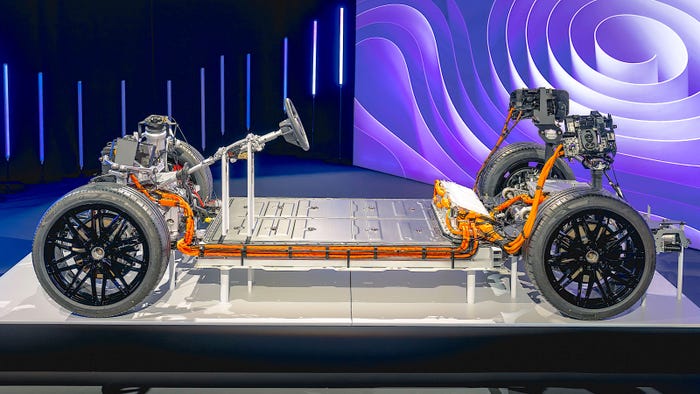
The 2024 Porsche Macan's electric drivetrain. PORSCHE
Charging
At its peak charging speed, the Macan can fill its battery from a 10 percent state of charge to 80 percent in just 21 minutes. The company predicts it will have 312-mile driving range on a charge, so an 80 percent charge would represent 250 miles of driving range.
When connected to the much more common 400-volt charging stations, the Macan separates the two halves of its back into two 400-volt batteries and charges them at their native voltage without the need to step voltage up through a transformer. The two halves of the battery charge simultaneously at a 135-kW rate. Level 2 AC charging at home, or other such chargers is 11 kW.
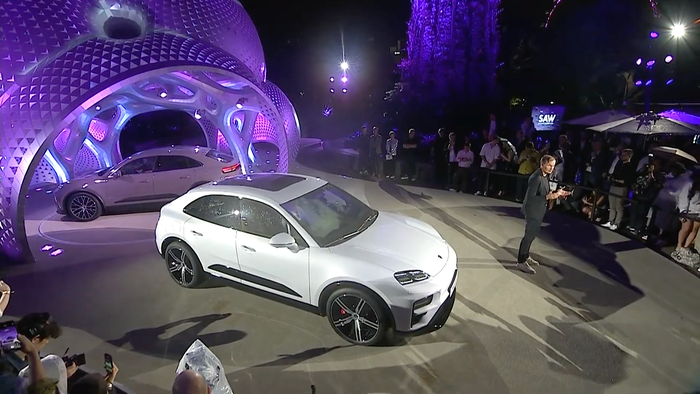
Porsche CEO Oliver Blume introduces the 2024 Macan in Singapore. PORSCHE
E-Motors
As we’ve seen previously with Rivian, the Macan employs silicon carbide power semiconductors in its more heavily taxed rear motor’s inverter, while using less costly silicon for the front motor’s inverter. The Macan can regenerate power while decelerating at the rate of 240 kW, letting it recover more energy than typical EVs can during the heavy braking a vehicle might experience during a spirited drive on mountain switchbacks or during a track day.
Just as Jeep needs to ensure that its latest vehicles continue to provide credible off-road capability, even if that is rarely used, so must Porsche ensure that new models like the 2024 Macan are ready for occasional track use.
The Macan 4’s electric drivetrain produces a peak of 402 short-burst “overboost” horsepower and 479 lb.-ft. of torque, which is sufficient to accelerate the vehicle to 60 mph in 4.9 seconds. The Turbo’s motors create 630 hp (also in overboost mode) and an impressive 833 lb.-ft. of torque, which launches it to 60 mph in 3.1 seconds. The Macan 4 reaches a terminal velocity of 136 mph, while the Turbo can reach 161 mph.
That power is electronically controlled by the Porsche Traction Management (ePTM) system, which is five times faster than a conventional all-wheel drive system, reacting to control wheelspin within 10 milliseconds. Power distribution to the Macan’s wheels is managed according to the drive mode the driver has chosen for the circumstances. Macan Turbo buyers can choose the optional Porsche Torque Vectoring Plus (PTV Plus) electronically controlled differential lock on the rear axle for enhanced traction, driving stability, and lateral dynamics.
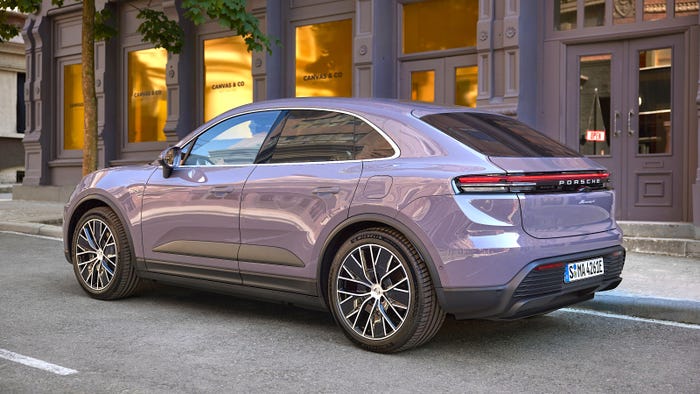
The 2024 Porsche Macan 4 Electric. PORSCHE
Chassis
At 188.4 inches, the new Macan is almost 2.5 inches longer than the outgoing combustion version and rolls on a 113.9-inch wheelbase that is nearly 3.5 inches longer. This provides additional space between the axles for the battery pack and also addresses the common complaint of compact crossover drivers that the back seat is cramped by adding rear-seat legroom.
Typically, having the battery in the floor raises the cabin in EVs, but the new Macan seats front-row occupants 1.1 inches lower than before and the back seat is 0.6 inches lower.
The added wheelbase can be detrimental to agility and ease of parking, so Porsche has installed a rear-wheel steering system with as much as 5 degrees of steering angle for a turning circle of 36.4 feet and responsive steering in switchback corners.
The mass of a battery pack is also unhelpful when it comes to providing the driving dynamics Porsche buyers expect, so the Macan is upgraded to the company’s air suspension with Porsche Active Suspension Management electronic damping control as standard equipment. The dampers are now double-adjustable, letting the computer change settings for compression and rebound independently of one another for maximum results. Additionally, the damper adjustment map is broader now, providing bigger changes between comfort and performance settings so that each of the five drive modes has more clearly discernable characteristics.
The new Macan is still recognizable, but with some obvious Taycan influences, especially around its headlights. This new body slices through the air more efficiently, with a 0.25 coefficient of drag. That compares to a 0.35 for the outgoing model, a change that is worth an extra 50 miles of driving range on the highway thanks to reduced drag.
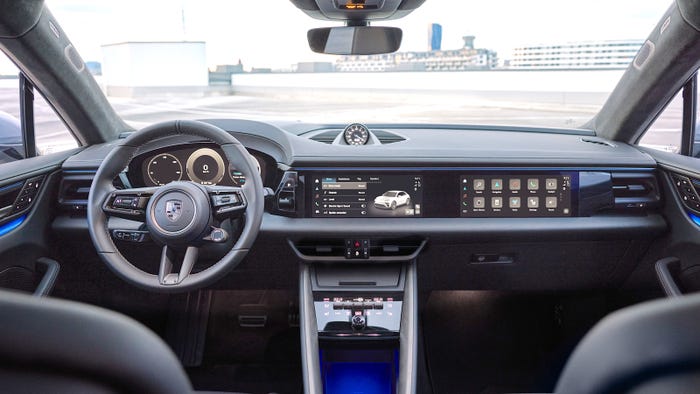
Porsche employs Android Automotive operating system for its infotainment system. PORSCHE
Cabin
Inside, Porsche has some surprises in store for Macan drivers. There’s an augmented reality head-up display and a curved 12.6 instrument display. The HUD projects information such as navigational turn arrows into space, on an area the equivalent of having someone place an 87-inch flat-screen television on the road 10 meters in front of the driver.
The 10.9-inch center display runs the Android Automotive operating system, which obviously supports Android mobile devices but which also provides Apple CarPlay for iOS phones. Porsche runs its own app store for apps to populate the system.
The company is seeking to be green through its selection of materials used in the Macan, with the floor mats and carpet made using Econyl, which comes from recycled nylon.
“The new Macan is cool, digital, and ready for exciting new experiences,” declared Porsche CEO Oliver Blume at the car’s press introduction in Singapore. We look forward to the Macan confirming those claims for us in person with a drive at the media launch.
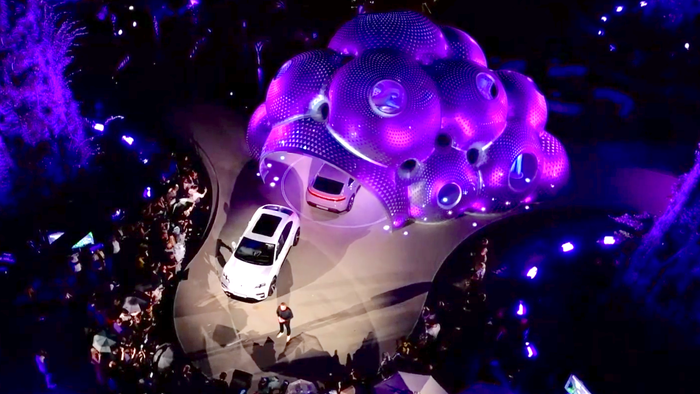
The Macan Electric press conference. PORSCHE
About the Author(s)
You May Also Like
